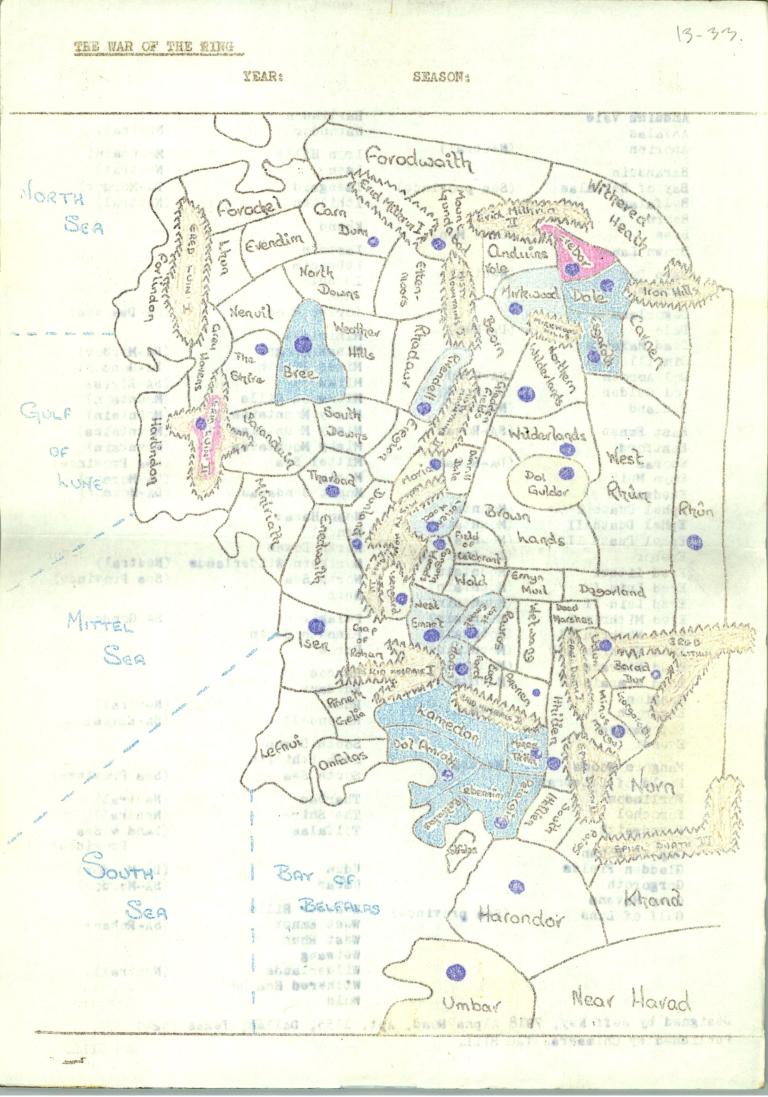War of the Rings

War of the Rings
User summary:
War of the Rings is a Diplomacy variant written by Jeff Key and published in Chimaera (Issue 13 - Mar 1976). The basic game follows the 1971 rules, but with numerous exceptions. The rules were accompanied by a custom color map.
The game supports six players and the named nations are Mordor, Rohan, Gondor, The Men of the North, The Elves, and The Dwarves. Although fleets and sea travel are de-emphasized, the map presents five sea areas. The initial setup does not contain fleets and fleets cannot be built. However the buildable unit "bunchaboats" is functionally somewhat similar. The land area is divided into an exceptional number of provinces, many of which have an indicated "terrain" that limits which types of unit may enter (for example, only Goblins, Ents, and Dwarves may enter mountain terrain). There are thirteen neutral supply centers at the start of play, including The Shire. The initial land setup heavily favors Mordor which starts with eight provinces; The Dwarves starts with two provinces; all other groups start with three provinces. This forces most, or all, of the players to align against Mordor. The initial units include special "double strength" and "triple strength" armies. During play, only normal strength armies can be created.
There is an additional special piece, The Ring, that begins in The Shire region. No player owns The Ring but any player can move The Ring with any army unit that moves from the area that holds it. Alternately, some units may "put on" The Ring which then becomes inseparable, conferring some significant benefits (including invisibility - the unit receives orders as usual, but they are not made public unless the unit engages in combat). If the unit "wearing" The Ring is destroyed The Ring remains in the province.
There are three separate victory conditions: (1) a player may move The Ring to Barad-Dur, destroying it; (2) the Mordor "triple strength" army (AKA Sauron) is eliminated; (3) the Mordor "triple strength" army and The Ring end a turn in the same province. In the case of (1) or (2), Mordor loses and the relative strengths of the remaining players are compared to determine a winner. In the case of (3), Mordor wins.
The rules also present several modifications to the standard rules, primarily regarding the "double strength" and "triple strength" armies. Too, four turns per year are played. Intended for postal play, the game supports traditional table play without alteration.
War of the Rings is a Diplomacy variant written by Jeff Key and published in Chimaera (Issue 13 - Mar 1976). The basic game follows the 1971 rules, but with numerous exceptions. The rules were accompanied by a custom color map.
The game supports six players and the named nations are Mordor, Rohan, Gondor, The Men of the North, The Elves, and The Dwarves. Although fleets and sea travel are de-emphasized, the map presents five sea areas. The initial setup does not contain fleets and fleets cannot be built. However the buildable unit "bunchaboats" is functionally somewhat similar. The land area is divided into an exceptional number of provinces, many of which have an indicated "terrain" that limits which types of unit may enter (for example, only Goblins, Ents, and Dwarves may enter mountain terrain). There are thirteen neutral supply centers at the start of play, including The Shire. The initial land setup heavily favors Mordor which starts with eight provinces; The Dwarves starts with two provinces; all other groups start with three provinces. This forces most, or all, of the players to align against Mordor. The initial units include special "double strength" and "triple strength" armies. During play, only normal strength armies can be created.
There is an additional special piece, The Ring, that begins in The Shire region. No player owns The Ring but any player can move The Ring with any army unit that moves from the area that holds it. Alternately, some units may "put on" The Ring which then becomes inseparable, conferring some significant benefits (including invisibility - the unit receives orders as usual, but they are not made public unless the unit engages in combat). If the unit "wearing" The Ring is destroyed The Ring remains in the province.
There are three separate victory conditions: (1) a player may move The Ring to Barad-Dur, destroying it; (2) the Mordor "triple strength" army (AKA Sauron) is eliminated; (3) the Mordor "triple strength" army and The Ring end a turn in the same province. In the case of (1) or (2), Mordor loses and the relative strengths of the remaining players are compared to determine a winner. In the case of (3), Mordor wins.
The rules also present several modifications to the standard rules, primarily regarding the "double strength" and "triple strength" armies. Too, four turns per year are played. Intended for postal play, the game supports traditional table play without alteration.
Player Count
2
-
6
Playing Time
360
Age
12
Year Released
1976